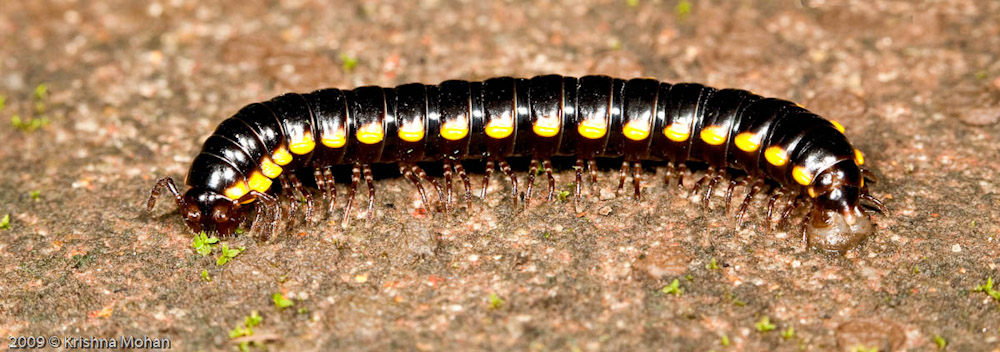
Even though this is a very common millipede in our garden I was not able to identify scientifically. This resembles morphologically the Apheloria genus found in America, but I doubt it belongs to that.
They do not bite humans. Generally found in leaf litter , millipedes tend to avoid light and may discharge a foul odor by secreting 2-Nitroethenylbenzenes to discourage predators. Pachydesmus crassicutis is known to produce hydrogen Cyanide gas to repel predators.
Millipedes, are arthropods that have two pairs of legs per segment (except for the first segment behind the head which does not have any appendages at all, and the next few which only have one pair of legs). Each segment that has two pairs of legs is a result of two single segments fused together as one. Most millipedes have very elongated cylindrical bodies, although some are flattened dorso-ventrally, while pill millipedes are shorter and can roll into a ball, like a pillbug.
Millipedes are detritivores and slow moving. Most millipedes eat decaying leaves and other dead plant matter, moisturising the food with secretions and then scraping it in with the jaws. However they can also be a minor garden pest, especially in greenhouses where they can cause severe damage to emergent seedlings. Signs of millipede damage include the stripping of the outer layers of a young plant stem and irregular damage to leaves and plant apices.
This class contains around 10,000 species. There are 13 orders and 115 families.
The giant African millipede (Archispirostreptus gigas) is the largest species of millipede.
It is now proved that this millipede is Anoplodesmus saussurii.
Check these discussion:
http://rmbr.nus.edu.sg/nis/bulletin2012/2012nis141-149.pdf
http://www.flickr.com/groups/myriapoda/discuss/72157631308138718/


Very well known millepede to all in south canara.
Yes, Surprising is that nobody knows the Id for this common millipede!
regards
Krishna Mohan
I’m no bug expert, but I believe it might be a specimen of Harpaphe haydeniana.
cf. http://images.google.com/images?q=Harpaphe%20haydeniana
Very nice nature photos by the way!
Olivier
Olivier, thanks for commenting at my blog. I also thought that it was Harpaphe haydeniana. But I doubt this American millipede is found in India. It is very common and resembles Harpaphe haydeniana. It smells odd but not like Almond or hydrogen Cyanide which Harpaphe haydeniana secretes. I did not dare to taste to find out. So I sent my cat to test. It found the secretion very irritating but not fatal. Cat was vomiting that whole day ;-). Lack of guides to identify such common species is a big hurdle.
regards
Krishna Mohan
It is now proved that it is not Harpaphe haydeniana, but is Anoplodesmus saussurii.
Check these discussion:
http://rmbr.nus.edu.sg/nis/bulletin2012/2012nis141-149.pdf
http://www.flickr.com/groups/myriapoda/discuss/72157631308138718/
http://rmbr.nus.edu.sg/nis/bulletin2012/2012nis141-149.pdf
saw these while clearing the compost pit and only learnt about them after reading your blog. I am an absolute novice. I’m just trying to understand these crawlies a bit more. You say that these milipedes that are dorso-ventrally flattened cannot roll into a ball but I saw these doing just that. Or maybe I understood the sentence wrong?
Thanks. Unlike rest of the millipedes they are not rounded in their body shape. They do curl to a ball, but it is sideways unlike other millipedes. Thanks for observing them 🙂
You are doing a wonderful job of documenting little creatures.
what happen when you eat that..?
my dog eats lot of it…and it suffer many symtoms like, running nose,cough,bleeding ears and nose…,hope u can tell for antidote of it,my pet is dying..
Sir are these edible for humans
Divit,
It will cause vomiting and retching as it contains weak cyanide compound, you might not die but vomiting might be pretty bad.